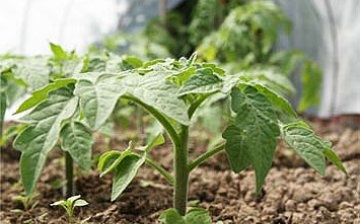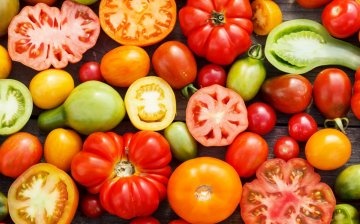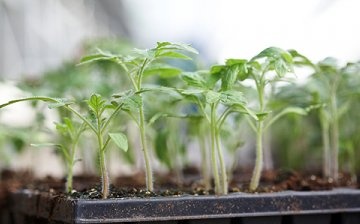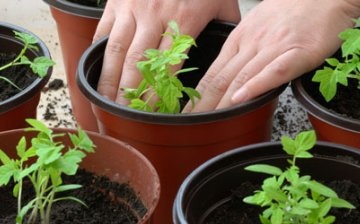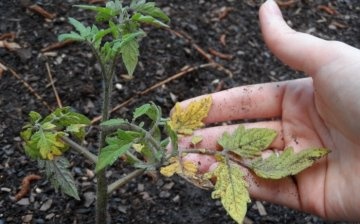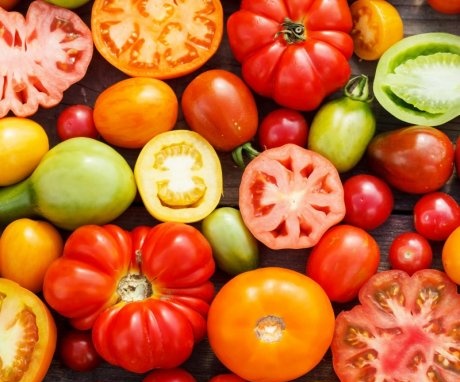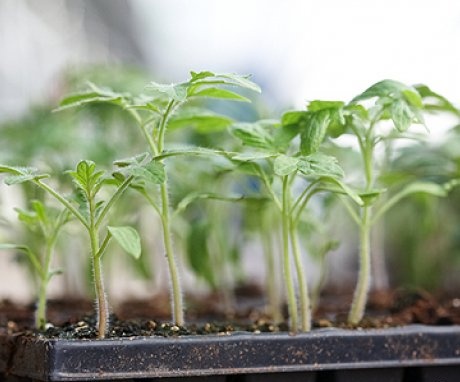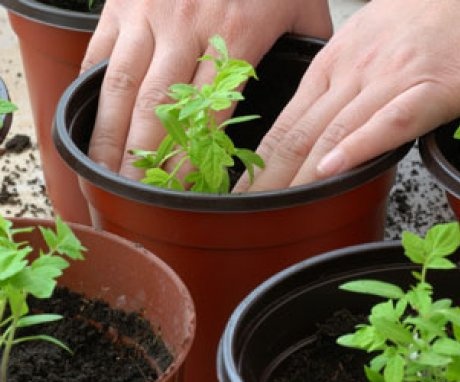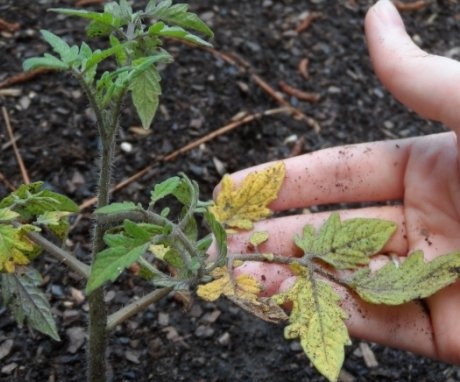Secrets of growing tomato seedlings without picking and with picking
Tomatoes belong to the nightshade family. Grows in nature as a perennial herb. At home, it is grown as a one-year-old. Tomatoes are native to the South American tropics. For a long time, after they appeared in the regions of Russia and Europe, they were grown as ornamental plants. Tomatoes were planted in flower beds and as house flowers in pots.
Tomatoes Are herbaceous plants that can reach 1.8 meters in height. Branches are spreading, pubescent, painted in light green or green tones. The leaves are soft, uneven, embossed, pointed at the end. The flowers are small, the petals are yellow.
Content:
- Popular varieties of tomatoes for growing
- Tomato care
- Growing tomato seedlings without picking and with picking
- Diseases and pests of tomato seedlings
Popular varieties of tomatoes for growing
Breeders from all over the world grow new varieties every year tomato... Today there are about 700 of them. The varieties are developed taking into account the growing region, the number of warm days and soil moisture.
There are also types with pink, yellow, black and orange tomatoes:
- Pink honey. Bushes of this variety stretch 60-100 cm in height. Branches are strong, pubescent, in need of additional support. Fruits are large, fleshy, sweet, pink in color when mature. Resistant to various diseases, normally tolerates temperature extremes.
- Orange. This is a tall variety. The stem of the bush stretches 1.5 meters, needs support. Fruits in a mature state acquire a bright orange color. They are round in shape, the flesh is fleshy, sweet. The weight of one fruit can reach 400 grams.
- Griffin. The variety is early maturing. Bushes of medium size have powerful branches. Ripe fruits have a pink uniform color, they are round-flattened in shape. The variety is resistant to diseases and quite unpretentious in care.
- Christina Plume. This is an early tomato variety. The bush is tall, the stems are strong, but they need support. The foliage is densely located on the branches, covering the tomatoes from the hot summer sun. The fruits have an unusual brindle green-red color. The shape of the tomatoes is plum-shaped, a whole bunch ripens at once.
- Ivanhoe. The variety belongs to the early, and has a high yield. Often used for industrial purposes. The bush has an average height of stems, strong branches. Fruits are round, shiny, evenly colored in a red tone.
Tomato care
How to care for tomatoes known to every summer resident. Tomatoes are such a popular plant that every family has its own rules and rituals for growing it. Many are planted seedlings at a certain phase of the moon, some mate with some kind of holiday.
Tomato varieties are unpretentious and resistant to various diseases:
- Melody. Super early hybrid variety. The bushes are tall, the branches are strong enough, but it is recommended to tie them to a support. Fruits of a rounded slightly flattened shape are colored in a bright red tone. The weight of one tomato can reach 230 grams. The variety is unpretentious and resistant to diseases.
- Pink Lady.This is an early ripe hybrid variety. The bushes are medium-sized, the branches are strong. Fruits are oval-flattened, pink in color. The pulp is sweet, juicy and fleshy. The variety is unpretentious in care and disease resistant.
Tomatoes relatively not whimsical plants and grow well and develop on almost any soil. The only condition is that they cannot be planted in the same place every year. That is, it is recommended to alternate the planting site with other plants on the site.
After disembarking seedlings in open ground, it is recommended to treat it with antiviral drugs. And after 3 weeks, you can start feeding the bushes with organic fertilizer. A mullein solution and a little fertilizer work well for this.
Tomatoes are moisture-loving plants, so it is recommended to regularly water them with plenty of water.
This is especially true during the hot and dry months of summer. After watering, you can sprinkle the wet soil with a small layer of peat or compost, which will serve as mulch for the plants and retain moisture for a longer period. Overflowing tomatoes is also not recommended, as the root system may suffer. Reduce watering during rainy weather or cloudy days.
Tall varieties need support, as their branches are not strong enough to support the weight of ripe fruits. To do this, near each bush, when it is still not very high, long stakes are buried. And as it grows, the tomato is tied to it. Also, if the seedlings were grown in the greenhouse, often each bush is tied up with stretch marks to the upper arches.
Growing tomato seedlings without picking and with picking
Reproduction of tomatoes takes place using seed, which are harvested from ripe fruits. But collecting seeds is not enough to make a good one. seedling, the stems of the plant were strong and firm, the seeds needed to be prepared. And depending on what results need to be obtained, various procedures are carried out.
Seedlings are grown in two ways:
- In the first method, young shoots dive
- The second method is growing tomatoes without picking.
Growing seedlings without picking:
- The seeds are disinfected in a weak solution of potassium permanganate for 20 minutes.
- After that, it is wrapped in damp gauze and left on the windowsill in a saucer for 2-3 days.
- Periodically it is necessary to add water so that the material does not dry out.
- The material for landing is ready. It is necessary to prepare containers and soil for work.
- Peat pots or special plates with cells with cubes, which are often used when growing tomato seedlings without picking, are well suited for these purposes. If the seedlings will dive, then you can use ordinary wooden boxes.
- Tomatoes are unpretentious to the type of soil, so you can purchase a ready-made substrate for nightshades in the store.
- It is not recommended to grow tomatoes in pure peat when transplanting in open ground they may not adapt well. All soil is treated with a hot manganese solution for disinfection.
- The seeding period is calculated for each region. Depending on weather conditions and temperature conditions, as well as the presence of a greenhouse in the country, the period is chosen from the end of winter - the beginning of spring, or the spring months.
- Seedlings can be planted in the ground when the top layer of the earth warms up by 10 cm.
- From planting to the finished seedling, the tomato develops in about 60 days.
Seeds are laid in a prepared container to a depth of no more than 1 cm.When preparing seedlings with subsequent picking, the distance between the seedlings is set aside about 1-2 cm.This planting will allow the seedlings to stay in the box for a long time and the root system of each sprout will have time to get strong enough. For self-cultivation of each individual tomato bush, the seeds are laid out in separate cells, 2 pieces each. It is not recommended to water the seeds after planting, as they can go deeper into the soil along with water.Prepared containers must be covered with foil or glass to form a greenhouse. The boxes are placed in a bright place in the room, where the air temperature does not drop below 25 degrees. Periodically, the soil is sprayed with a spray bottle so that it does not dry out. Seedlings should appear a week after planting.
2 weeks after germination and when two adult leaves appear, the seedlings can be dived into separate pots. To do this, it is necessary to water the soil well in a container where young tomatoes grow. Further, each individual sprout is taken out with a spoon and transferred to a prepared glass or peat pot with soil. We make a hole in the substrate, and plant a young tomato in it. Water well. The next watering is recommended only after a week.
When growing tomatoes without picking, the sprouts are rolled over into containers larger than the previous ones.
The process is a little easier, since young seedlings can be planted together with peat cups, which themselves decompose and serve as additional food.
Diseases and pests of tomato seedlings
When growing seedlings the problem of stem decay is common. This disease can occur for the following reasons:
- Strong overflow of the substrate and waterlogging of the soil.
- Dense planting of seeds.
- An insufficiently bright place was chosen for germination and development.
- The ambient temperature is too high.
Tomatoes are mainly used for food. Over the long period of growing this plant in culture, there are many recipes for preparing this fruit, both ripe and green. Also, tomatoes are canned for the winter on their own or as part of salads.
More information can be found in the video.



